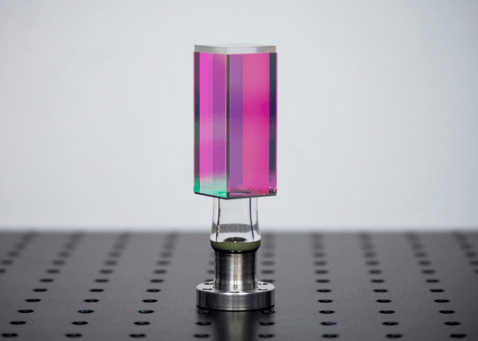Infleqtion is developing the next generation of quantum tools, including clocks, gravimeters and motion sensors so precise they can replace GPS.
Forward: features are independent pieces written for Mewburn Ellis discussing and celebrating the best of innovation and exploration from the scientific and entrepreneurial worlds.
‘Today we are on the cusp of commercial optical clocks that tick over one hundred trillion times per second and are accurate to within one second over the entire age of the universe,’ says Paul Lipman, Infleqtion Chief Commercial Officer.
One second over the entire age of the universe – this is quite a claim. It brings to mind Woody Allen’s quote about eternity being a long time, ‘especially the bit at the end’. Quantum clocks are precise to a degree barely comprehensible by the rational mind.
But Infleqtion is a company in the business of creating extraordinary devices. It employs more than 90 PhDs to design and manufacture quantum products of phenomenal precision.
It is working on a quantum gravimeter, able to measure minute fluctuations in the gravitational fields, making it possible for an aeroplane with a gravimeter to detect hidden bunkers or volcanoes about to erupt as the magma increases in density. Quantum accelerometers measure movement with such accuracy they track the geolocation of an object as it travels over thousands of kilometers.
The company makes quantum processors too. Infleqtion’s Hilbert quantum computer is based on trapping caesium atoms in a grid of lasers that cool the atoms to near Absolute Zero to induce a Bose-Einstein condensate. In this condition, the quantum properties of the atoms can be read by another laser. A Bose-Einstein condensate is fleetingly rare to find outside textbooks. It is a fifth state of matter, when atoms are cooled to near -273.15C or zero Kelvin, so coalesce into a single quantum entity.
The science of precision
On studying the library of devices made by Infleqtion, two questions arise.
The first is how Infleqtion achieves such precision at the quantum level? There is, in fact, a common theme: manipulating atoms with lasers. But how? Isolating a single atom in a laser grid, for example, sounds... difficult.
The second question is the impact these devices will have. How are these remarkable devices to be used?
Let’s start with the technical question. How does one trap an atom with lasers to slow it to near Absolute Zero?
‘It’s not easy,’ admits Bob Sutor, Infleqtion’s chief quantum advocate and veteran of the industry for more than three decades.

Bob Sutor, VP and Chief Quantum Advocate
(Credit: Infleqtion)
‘It’s like atoms in the air,’ explains Sutor. ‘The molecules in a room move around faster on a warmer day. Put on an air conditioner, the room becomes colder and the atoms slow down. Their temperature is proportional to their speed. We use lasers of the appropriate frequency to slow the atoms, and so they get colder. We bring the atom, be it caesium or rubidium or whatever, to a standstill, with a little vibration.’ The control is precise. ‘We can fix the atom in three dimensions. This is how we can put atoms in a chequerboard formation for quantum computing.’
Infleqtion makes a device called a Magneto-Optical Trap, or MOT, which offers this laser cooling and manipulation function to researchers worldwide. The MOT chamber is a vacuum that holds a vapour cloud of caesium or rubidium atoms.
The number of atoms trapped in the MOT depends on the project. ‘It could be a grid of ten by ten atoms for our first-generation Hilbert quantum computer. Other times it could be millions of atoms, depending on your purpose.’
The size of the atomic pattern is small. ‘A grid of 35 by 35 atoms for a quantum computer, so 1,225 atoms, is within the width of a human hair.’ A million quantum computer qubits will fit inside the size of a thumbnail.
A single laser is used in the MOT. Optical methods split and control the beam as needed. ‘Our strength is our ability to control the laser,’ says Sutor. ‘If we are slightly off, we could miss the atom and hit a nearby atom. It’s about precise control.’
The effect typically lasts for up to ten seconds. Long enough for quantum calculations. For example, in April 2022, scientists from Infleqtion, University of Wisconsin-Madison and UK company Riverlane demonstrated several of the core algorithms for quantum computing. Cold atom quantum processors are noted for their low noise levels – a major competitive advantage compared with rival architectures such as silicon-based quantum chips. The Hilbert team are aiming to scale up to more than a thousand qubits by 2024.
Infleqtion also makes a doubleMOT. ‘The doubleMOT is a self-contained, tabletop, ultra-high vacuum system that makes it easy to cool and trap atoms, with applications ranging from fundamental quantum physics research to developing sensors and new quantum technologies,’ says Sutor.
.png?width=210&height=410&name=Infleqtion-doubleMOT%20(1).png)
Infleqtion's doubleMOT
(Credit: Infleqtion)
The dawn of quantum timing
Quantum clocks are another speciality. The company is not alone in making these precision timing devices, but excels in the quality of the product, the size and cost. Infleqtion is also a pioneer in pairing quantum clocks with other quantum hardware such as gravimeters and accelerometers.
The clocks are useful by themselves. ‘There is an immediate application for ultra-precise timing in the field of computing and high-speed networking,’ says Sutor. ‘If you have many transactions coming in quickly that need to be kept in the right sequence, a quantum clock really helps.’ Infleqtion believes there is a large worldwide market waiting for this application alone.
Infleqtion is now looking at using these devices in combination. Add a quantum clock to a motion sensor, and it’s possible to track the movement of an aeroplane, car or submarine.
‘The military is interested,’ says Sutor. ‘GPS can be interfered with or spoofed in wartime situations. GPS is less accurate in bad weather and disrupted by storms. We need an alternative system.’
The principle is identical to that adopted by 18th century ships. The author Dava Sobel chronicled the race to produce an accurate clock to position ships on ocean voyages in his bestseller Longitude.
As Sobel explained, calculating longitude is not easy. A solution lies in measuring 24-hour periods. Take the sun’s zenith at noon as the starting point and measure the time until noon the next day, and the change in longitude is apparent: a difference of one hour means the ship has travelled 1/24 of the way around the world, or 15 degrees. Naturally, most journeys are a lot shorter, often just a few seconds of difference.
The trick is to time noon to noon accurately.
Inventor John Harrison spent 43 years developing his mechanical clock – the first prototype appearing in 1737. His chronometer proved accurate enough to crack the longitude problem and is credited with the opening of global trade.
Harrison’s H4 clock, completed in 1759, ticked five times a second and was accurate to one second per month. A quantum clock, as noted, is precise to one second until the end of the universe.
‘Suppose we wish to measure the flight path of an aircraft without GPS,’ says Sutor. ‘We can use the quantum clock to time how long it has been in the air. We then use quantum gyroscopes to measure rotation. We use quantum inertial sensors to measure movement in three directions, so any movement of the aircraft is recorded. Combine these readings and we’ll know where the aircraft ends up, provided we know the starting point.’
Quantum positioning is unspoofable and unaffected by bad weather. It can be used on submarines too – hence the keen interest from the military.
Quantum radio
Fuzzy FM radio is another problem that can be solved by quantum devices. Sutor is enthusiastic about the potential of precise radio broadcasting. ‘In the old days, you’d be driving your car and be tuned into, say, Radio Oxford on 98.8 FM. Then you'd drive to Cambridge, and another station on a similar frequency interferes. You get both radio stations. What you need is a precise antenna so there’s no interference. This is what quantum radio offers.’
The architecture of quantum hardware is attractive too. ‘Look at a mobile phone tower – the boxes are large. The size of the antennae is related to the frequency. Quantum radio devices can be small, maybe the size of a smartphone, just three or four times as thick. And you can tune to multiple frequencies,’ says Sutor.
BT is one of the telcos looking at quantum radio.
The emergence of quantum devices means Infleqtion’s library of hardware will be in growing demand. This is the company’s purpose: it makes the kit that others can deploy. Infleqtion’s atomic prism, for example, has multiple purposes. ‘It’s a “quantum light bulb”,’ says Sutor. ‘It’s a glass prism holding a cloud of atoms in a vacuum. We can shoot lasers up through the sides. Or in some cases up the middle.’

Infleqtion's Atomic Prism (2cm AR-Coated Cell)
(Credit: Infleqtion)
The future of quantum devices
The products produced by Infleqtion offer a glimpse into the future of quantum hardware. The timeline for full commercial deployment is long. Small quantum computers, for example, are available now, but are five to ten years away from scaling up for everyday production use.
Quantum positioning systems are large and expensive for current applications, but Infleqtion is keen to drive the size and cost down. ‘We have worked with NASA and DARPA [the US military research arm]. We’ve won various specific awards and grants, including from Innovate UK. In 2019 we had a Series A funding round of US$32m primarily focused on quantum computing and we closed a Series B last year for US$110m.’ Sales to university labs and quantum companies are accelerating.
‘We are moving towards the commercialisation of quantum devices such as clocks and RF receivers,’ reveals Sutor.
The ethical philosopher Derek Parfit, who spent his career at All Souls College, Oxford, would respond to questions of what he was working on with: ‘I work on what matters.’ The employees of Infleqtion could respond alike. Quantum devices offer performance many orders of magnitude superior to classical devices. The atomic prisms and Magneto-Optical Traps made by Infleqtion are more than beguiling and beautiful – they are devices that capture fundamental properties of the universe and make them available to the wider world. The company has a mission beyond any mere commercial purpose.
‘Quantum is the nature of reality,’ says Sutor thoughtfully, while looking at an atomic prism. ‘Our devices are based on the way the universe really works. We make quantum matter, in all the senses of that statement.’
Commercial promise
Andrew Fearnside, Senior Associate and Patent Attorney at Mewburn Ellis:
“Quantum sensors have the potential to transform many sectors of industry. Infleqtion has appreciated this potential and the commercial promise it holds. The quantum states of atomic particles are exquisitely sensitive to their environment. While this proves to be something of a headache for quantum computing, it is an asset for quantum sensing. Quantum sensors can take advantage of this sensitivity to make precise measurements of the world around us in a way that classical devices cannot hope to match. As a clear leader in this field of quantum technology, Infleqtion is the one to watch.”
Written by Charles Orton-Jones
Andrew is a Senior Associate and Patent Attorney at Mewburn Ellis. He works primarily in the fields of telecoms, electronics and engineering, and specialises in quantum technologies, photonics and ion optics. Andrew has extensive experience of drafting and prosecution, global portfolio management and invention capture to secure a commercially valuable IP portfolio. He also conducts freedom to operate analyses and performs due diligence.
Email: andrew.fearnside@mewburn.com


.png)
-Dec-29-2025-09-11-25-2361-AM.png)